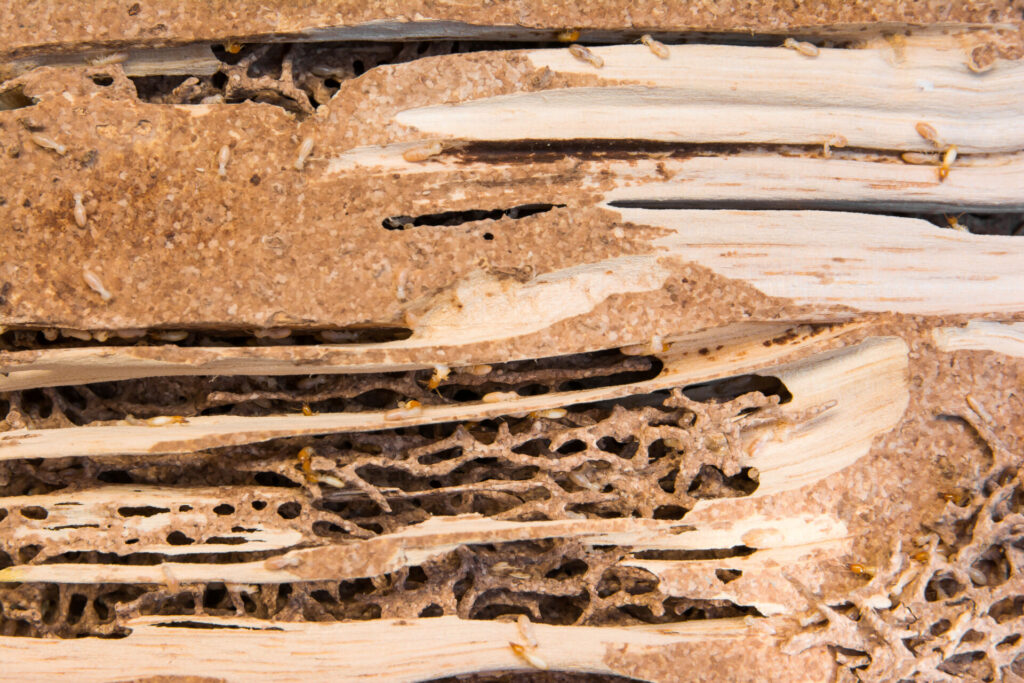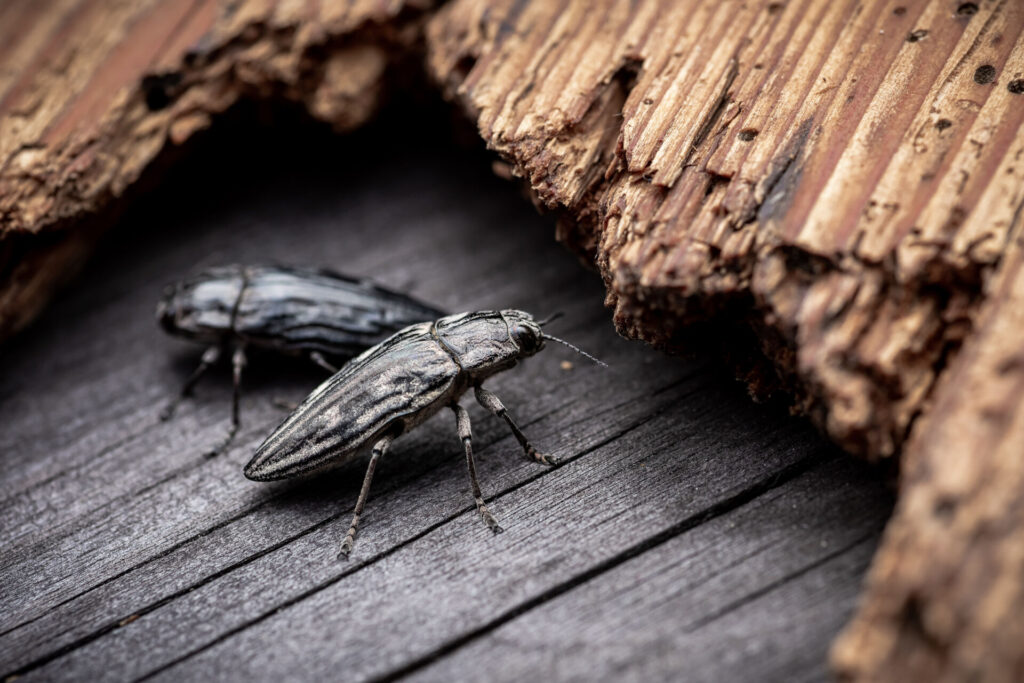When you think of the insect most likely to wreak havoc on your home, the termite is probably the first to come to mind. Termites thrive in our southeastern climate and outdo all other species of insects when it comes to foundational and structural damage to a home. But even though the termite is number one on the leaderboard of wood-destroying insects, there are a few more insect types that can pose a risk to your home’s integrity.
About Termites
Before diving into information about other wood-eating insects, let’s look at what makes the termite so much more destructive than all the others. We’re specifically looking at the eastern subterranean termite, since that is the one that is most common in Georgia and the Southeast:
- In the South, there are millions of subterranean termites per acre of land. Any given acre of land, including yards and lawns, can contain 10-20 colonies of termites. Each colony can have 100,000 termites or more.
- If a colony finds your home, they will build tunnels from the ground to the foundation of your home and will begin feasting. You will not see them in action since their tunneling techniques keep them underground.
- Swarmers are the only types of termites that come out of the ground. They appear during mating season and are only above ground for 30-40 minutes before they return to the soil or die of dehydration. Swarmers shed their wings, so finding termite wings outside is a sign that at least one colony is nearby. If you see termite wings indoors, it’s a surefire sign of a termite infestation.
- By the time you discover signs of termites in or around your home, it is likely too late—the colony has begun feeding on your home’s wood sources and has probably already caused costly damage.

Protection Against Termites
While termites can seem unavoidable, there are ways to protect your home and prevent a termite infestation from ever occurring.
Solutions include:
- Termidor, a liquid termite treatment solution. Home and property owners can rely on Termidor to prevent termites or to treat an active infestation. Termidor works as an odorless poison that termites crawl through and spread to other termites in the colony. Each affected termite becomes a carrier of Termidor, allowing it to spread quickly and wipe out all colony members with efficiency. This solution is applied outside the home’s perimeter and offers years of protection.
- Sentricon, a baiting system that has been proven to eliminate termite colonies and prevent them from reaching your home. A series of baiting stations are installed in the ground around your home. Each station contains a substance that is highly attractive to termites. A termite can feed on the solution and then pass it along to the other termites nearby. Even if a termite does not reach the station, the product will eventually reach them. Just like Termidor, the Sentricon solution will eradicate an entire colony fast.
- Bora-Care, a long-term and natural solution for preventing infestations of termites and other wood-destroying insects and organisms. Bora-Care is applied to foundational or structural wood to prevent harmful insects or organisms from feeding or burrowing. The Bora-Care solution penetrates the wood and remains active for up to 30 years, offering an environmentally safe yet effective solution for termite control.
Other Wood-Destroying Insects to Watch For
In addition to termites, it’s wise to be aware of other wood-destroying insects that can wreak havoc on your home’s foundation and wooden components. Keep your eye out for pests like:
Carpenter Ants
Similar in appearance to your average black ant, the carpenter ant digs into the wood, hollowing it out to build its nests. They do not feed on wood like termites, but they prefer to make their homes out of wood, especially wood that has been damaged or softened by moisture.
Types of Damage Carpenter Ants Can Cause
- Structural damage—Because carpenter ants dig and tunnel within pieces of wood, whatever piece they have infested can become structurally compromised.
- Cosmetic damage—The holes and tunnels carpenter ants carve out can be large and prominent, destroying the look of whatever piece they have burrowed into.
Signs of an infestation include:
- Frass, or wood powder on the floor or ground
- Holes or tunnels in pieces of wood
- Faint rustling sounds in your walls
- Paths of large, black ants throughout your house or yard
- Spotting swarmer ants in or near your house
Carpenter Bees
Carpenter bees are similar in appearance to the bumble bee with their black and yellow coloring and slightly fuzzy appearance. However, carpenter bees are much more destructive since they drill into wood for burrowing purposes.
Types of Damage Carpenter Bees Can Cause
- Structural damage—Since carpenter bees burrow into wood to build nests, they could choose your foundational pieces as their new home. If so, they will eventually weaken the strength and integrity of your posts, beams, or any other available wood.
- Cosmetic damage—If you have a carpenter bee problem, furniture pieces like tables, chairs, couches, and bookshelves can potentially become their new nesting source. This means your wood pieces can become structurally weakened and unsightly.
- Water damage—Carpenter bees tend to burrow in wood that is shielded from rain and other water sources. However, it’s not unheard of for a bee to drill into areas of the home that are exposed to rain. Should they create a hole that is exposed to the elements, you will likely experience water damage on top of any structural damage.
- Woodpecker damage—Carpenter bees are a food source for woodpeckers. If a woodpecker finds and targets a nest within your wood structure, you could experience even more damage to your foundational or structural components.
Signs of carpenter bees include:
- Frass, or wood powder on the floor or ground
- Holes the size of your fingertip burrowed into wood pieces
- Faint buzzing sounds coming from wood structures
- Carpenter bees in or near your home
Powderpost Beetles (Or Wood-Boring Beetles)

“Powderpost beetles” is a catchall term for several wood-boring beetles that burrow into hardwoods for nesting purposes. Experts consider these beetle types second to termites in the damage they can create for home and property owners.
Types of Damage Powderpost Beetles Can Cause
- Structural damage—If a powderpost beetle finds a piece of wood that has not been treated, painted, or sealed, it will burrow in, compromising the strength and integrity of the wood.
Wood-boring beetles commonly feed on wood types like:
- Ash
- Bamboo
- Hickory
- Oak
- Pine
- Walnut
Signs of an infestation include:
- Frass, or wood powder on the floor or ground
- Small, rounded holes in wood structures
- Tunnels within wood structures
- Weakened floorboards
- Wood-boring beetles (or their larvae) in or around your home
For the ultimate protection against termites and other wood-destroying insects, choose termite and pest control services from Bizzy Bee Exterminators.
From termites to carpenter ants, carpenter bees, powderpost beetles, and more, our exterminators have the skills and solutions to treat your home and protect your foundational or structural components. Schedule an inspection today and learn how to shield your home from Georgia’s dangerous, destructive insects.
Call us to schedule termite control or pest control at your home today: 1-800-273-4958
Recent Articles
